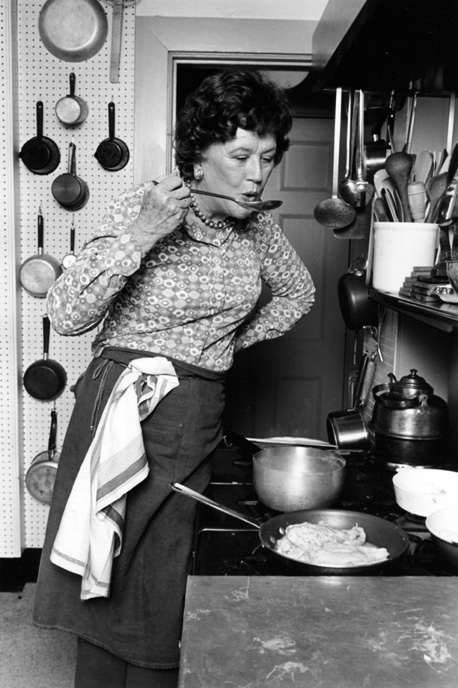
Mention Julia Child and the image that comes to mind is a tall woman with a spoon in one hand, saying in a high voice, “Bon appetit!” That was Child in her heyday as a 1960s TV show host teaching Americans the art of French cooking. But a new photo exhibit at California’s Napa Valley Museum Yountville documents her life in France in the years before she hosted one of America’s most popular TV cooking shows. (Photo by Lynn Gilbert – Own work, CC BY-SA 4.0)
YOUNTVILLE, Calif.—Mention Julia Child and the image that comes to mind is a tall woman with a spoon in one hand, saying in a high voice, “Bon appetit!”
That was Child in her heyday as a 1960s TV show host teaching Americans the art of French cooking. But a new photo exhibit at California’s Napa Valley Museum Yountville documents her life in France in the years before she hosted one of America’s most popular TV cooking shows.
Child, a graduate of Smith College, worked during World War II for the agency that was the predecessor of the CIA. In 1946, she married Paul Child, who worked as a cultural attache at the U.S. embassy in Paris while his wife learned how to cook at the famed Le Cordon Bleu cooking school, subsequently studying with several famous chefs.
That period of her life was documented by Paul Child and is the subject of the show, “France is a Feast: The Photographic Journey of Paul and Julia Child.” The exhibit was inspired and shown in conjunction with the release of the book “France is a Feast” by Paul Child’s great-nephew, Alex Prud’homme, and Katie Pratt, the Childs’ longtime friend, who also curated the exhibit.
The exhibit features 60 rarely seen black-and-white photographs taken between 1948 and 1954 along with notebooks, logs, letters and a Rolleiflex camera that Paul Child liked to use because it allowed him to look down and capture people unobtrusively.
“Julia and Paul loved France, especially Paris,” said Pratt. She explained that the couple often took walks on weekends, and Paul would look for subjects that appealed to him, including architecture, rivers, fisherman, children and cats. Since Julia was 6 foot 2 (1.9 metres), she could help him take pictures by blocking the sun. Her role, as she told Pratt, often was that of a prop.
Other pictures range from her early cooking years to art shots like one of her legs in a telephone booth beneath a bright light. Photos of daily life show her looking down from the top of a spiral staircase, sitting in their living room with their cat, picnicking, and on their many trips travelling the countryside visiting castles. On the back wall of the exhibit is a large “selfie” of Paul and Julia sitting on their porch in Marseille, having a lunch of wine and mussels. Also in the exhibit is a cameo (nude) silhouette of Julia looking out a window with a reflection in a mirror.
Through his work at the embassy, Paul met and was influenced by many photographers of the day including Edward Weston, Man Ray and Brassai. Through Pierre Gassmann, the master printer who founded Pictorial Service and did Paul’s darkroom work, he met and was influenced by Henri Cartier Bresson and Robert Capa.
Prud’homme said Paul was “talented, methodical in his work and happened to be in the right place at the right time.” He said his best pictures “combine abstraction and reality with a narrative behind them. For example, a photo of hanging laundry represents the people that wear the clothes even if the people aren’t in the clothes in the photo. On the one hand, they are a formal study of shape and texture and light and dark, but on the other hand, they tell a story about the people that used that laundry — looking at laundry is like peeping through a keyhole.”
Both Pratt and Prud’homme said the Childs — he died in 1994, she in 2004 — would have loved the exhibit. “Paul was a modest guy, but I think he was ambitious for his work,” said Prud’homme. “He had several shows. Edward Steichen picked some of his pictures for MOMA,” New York’s Museum of Modern Art.
The Yountville museum is in the heart of the Napa Valley and not far from Thomas Keller’s French Laundry restaurant and just above the Domaine Chandon winery. “Being in Yountville, which is one of the top culinary destinations in the world, that there’s such interest and passion for it here, we thought it was the perfect subject matter,” said museum director Laura Rafaty.
Plans are under way to take the exhibit to 10 other cities.
“Julia felt he never got the credit he deserved in his lifetime, and so when Katie suggested to Julia near the end of her life that we do a book of photos as a tribute to Paul, she immediately said yes,” said Prud’homme, “and she would be thrilled to see this.”